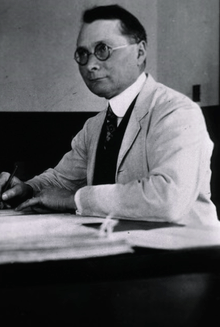John Edgar Coover
| John Edgar Coover | |
|---|---|
 | |
| Occupation | Psychologist, parapsychologist |
John Edgar Coover (March 16, 1872 – February 19, 1938), also known as J. E. Coover was an American psychologist and parapsychologist known for his experiments into extrasensory perception.[1][2]
Career
Coover carried out a psychical research programme at Stanford University (1912-1917).[3] He conducted approximately 10, 000 experiments with 100 subjects to test for extrasensory perception (ESP). He concluded after four years of research that "statistical treatments of the data fail to reveal any cause beyond chance". He also conducted 1,000 experiments with psychics and it was revealed that they had no advantage of any supposed psychic ability over normal subjects.[3]
His book Experiments in Psychical Research (1917) was well received by the scientific community for its methodology, rigorous statistics and use of experimental controls. It was considered a debunking work of psychical research by the psychologist Edward B. Titchener.[3]
Coover had criticized the "metapsychism" of parapsychologists as it did adhere to the scientific method.[4] He was highly critical of mediumship which he considered the result of credulity and deception. This led to a dispute with Thomas Welton Stanford a wealthy spiritualist who had help fund the psychical research programme at Stanford University.[3] Stanford had endorsed the fraudulent medium Charles Bailey as genuine and requested for Coover to test the medium. However, Coover held strong doubts about Bailey and noted he been exposed as a fraud several times, most notably by the Society for Psychical Research.[3]
Aftermath
Although Coover attributed his results to nothing beyond chance, other parapsychologists such as Robert H. Thouless claimed that when certain data from his experiment was lumped together, it revealed evidence of a small psychic effect. This was denied by Coover who suggested there may have been recording errors on the part of the experimenter.[5][6]
Publications
- Formal Discipline From the Standpoint of Experimental Psychology (1916)
- Experiments in Psychical Research at Leland Stanford Junior University (Stanford University Press, 1917).
References
- ↑ "Memorial Resolution: John E. Coover (1872 - 1938)" (PDF). Stanford University Academic Council. Archived from the original (PDF) on March 11, 2016. Retrieved March 31, 2016.
- ↑ Ogden, R. M. (1919). Review of Experiments in Psychical Research at Leland Stanford University. Psychological Bulletin 16 (10): 363-368.
- 1 2 3 4 5 Asprem, Egil. (2014). The Problem of Disenchantment: Scientific Naturalism and Esoteric Discourse, 1900-1939. Brill Academic Publishers. pp. 355-360. ISBN 978-9004251922
- ↑ Kurtz, Paul. (2001). Skepticism and Humanism: The New Paradigm. Transaction Publishers. p. 50. ISBN 978-0765800510
- ↑ Moore, Robert Laurence. (1977). In Search of White Crows: Spiritualism, Parapsychology, and American Culture. Oxford University Press. p. 274. ISBN 978-0195022599
- ↑ Carroll, Robert Todd. "A Short History of Psi Research". The Skeptic's Dictionary . Retrieved 28 March 2016. "Others examined Coover’s data and found more than Coover did. Radin writes that the receivers’ ability to guess the right cards rated 160 to 1 against chance (1997: 65). F. C. S. Schiller found the data showed odds greater than 50,000 to 1 against chance, but he used only the data from the fourteen highest-scoring subjects. Coover replied that he could find all kinds of interesting antichance events if he were selective in his use of the data (Hansel 1989: 28). In 1939, psychologist Robert Thouless (d. 1984) found that if the data were lumped together from the main experiment, there were 44 more hits than expected by chance. Thouless suggested that the data supported some slight psychic effect. He calculated the odds of this happening by chance to be about 200 to 1. Coover attributed the excess hits to recording errors on the part of the experimenter."